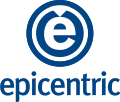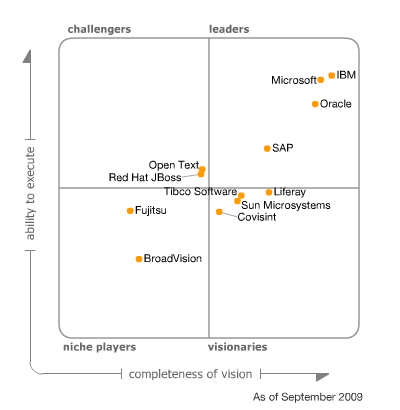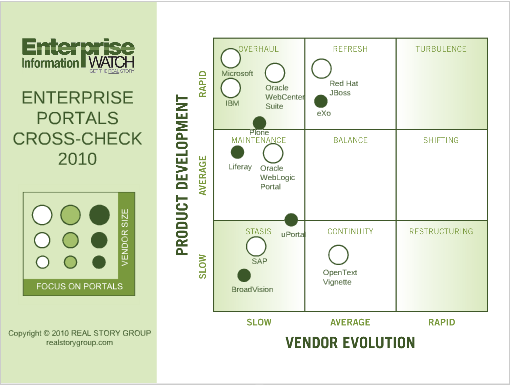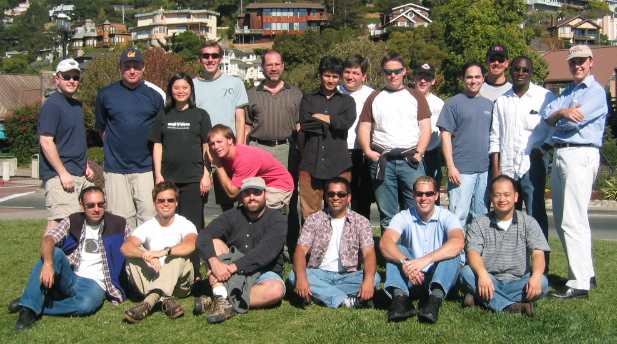Portals Are Operating Systems
February 22, 2010 by John Petersen
In discussions about how the web has affected the operating
system business, the browser is generally considered to be the heir to the
desktop, and Google the primary pretender to Microsoft's throne. While web
technology has no doubt undermined Microsoft's ability to dictate what the
preeminent application environment of the future will be, most analysis of the
ongoing operating system wars limits itself to client-side technologies and the
consumer market. Yet a significant front is being fought on the server side and
in the enterprise — the under-appreciated battle to determine what will
become the dominant enterprise portal platform.
The web OS of the future may not be called a portal. Naming trends go in and
out of fashion, and though there are recent indications that
portals are back,
portals are cool again, and
portal software is enjoying a new renaissance, there is also a
vendor-driven trend towards rolling portals up into broader multi-category
middleware brands like Microsoft SharePoint, Oracle Fusion, and IBM WebSphere.
(Aside to Open Text: Why are you retiring the name LiveLink, which had
great potential to become one of these broadly applicable brands?) But the
vagaries of naming and marketing don't change the fundamental game: to try to
own the server-side web application hosting environment that most business
software vendors and developers code to, integrate to, and deploy to. Whatever
its name, this new server-side operating system will functionally resemble an
enterprise portal.
Multiple maturing technologies — Linux, mobile, virtualization, the
cloud, and overarching all, the web itself — have combined to commoditize
the traditional operating system. On the client, the web OS has always existed
within a browser, but on the server it has migrated up the stack from web
servers to application servers to portal servers, each layer adding new
infrastructure and services previously considered non-core. Like sediment, the
surface sands of software gradually sink, stabilize, and calcify into bedrock
as new layers press down from above. This upward evolution has affected
repositories: the RDBMS has now sunk below the surface of relevance, displaced
from above by the CMS. What has emerged as the de facto operating system in
many organizations is something that former Gartner analyst David Gootzit
called the "portal fabric" — a web integration layer of interconnected
portal servers (increasingly a heterogeneous mix from different vendors),
stitching together all of the organization's software into a unified,
personalized quilt.
The threads of the portal fabric will bind to any imaginable web-enabled
software or API. For fast, lightweight integrations there is
widget/gadget/mashup support, exposing and embedding UI snippets via DHTML.
Deeper integrations open up with portlets and web parts, which can
programmatically interact with a vast array of libraries, APIs, and SOA
services. In the Java world, the JSR portlet specifications provide a
pluggable, standards-based approach to portlet development. The
under-appreciated JSR-286, in particular, represents a major step forward for
portal technology. Prior to this spec's adoption, it would have been difficult
to call portals true operating systems; but with it, portlets developed
independently by different developers or vendors can now communicate with one
another on the same web page. JSR-286, especially in combination with AJAX,
brings portal pages to life in a way that rivals the desktop, both visually and
technically. WSRP is
another important portal standard. It has not seen the same level of adoption
as the JSR portlet standards, but it should get a boost with SharePoint 2010's
support for bi-directional WSRP 2.0. WSRP provides a great way to federate
different portal products in increasingly common heterogeneous portal server
topologies.
Microsoft understands that the operating system is moving up the stack in
the enterprise and its solution is SharePoint. After many years of playing
catch-up, SharePoint is now a category-busting front-runner across the entire
Portal, Content, and Collaboration (PCC) middleware landscape. Taking a page
from the MS Office playbook, the SharePoint team rolled mulitple products into
a single suite; and while no specific component of that suite can be considered
best-of-breed, the combined integration is indeed greater than the sum of its
parts. SharePoint's portal component still leaves something to be desired
relative to its competitors, both functionally and in terms of lock-in. Without
a web part standard as open and portable as Java JSR portlets, there is no
viable path for migrating SharePoint web applications onto non-Microsoft server
platforms. But that is hardly surprising given that Microsoft of all vendors
understands best that portals are operating systems. No-one expects to move
their Windows applications onto other operating systems either.
Closing in on $500M in revenues with WebSphere Portal, IBM is the
single-product portal market leader. WebSphere Portal evolved rapidly through
the mid-2000s, but the pace of innovation has stalled recently on its 6.x
series (7.0, though delayed, should launch soon). Yet it is still a highly
capable offering with strong support for open standards. Where Microsoft built
SharePoint to protect and extend its operating system business, IBM built
WebSphere Portal to protect and extend its application server business, which
was becoming commoditized at the hands of pure-play portal vendors. IBM has
essentially vertically combined its application server with its portal server,
and now seems poised to horizontally combine its
portal and WCM offerings. Given its painful history with MS-DOS, Windows,
and OS/2, IBM knows what is at stake here, and is fighting for a second chance
at operating system hegemony.
The next strongest competitor in the portal market is probably Oracle,
although with five portal products on its hands now — two homegrown, two
as a result of the BEA acquisition (BEA's homegrown product, plus ALUI,
formerly Plumtree), and at least one as the result of the Sun acquisition
— Oracle Fusion is an integrated middleware suite in name only. There is
a lot of great technology kicking around in that portfolio, and the combined
market share of Oracle's portals rivals that of IBM WebSphere Portal at almost
a third of the market each. However, it will take time to digest these
disparate products, and in the meantime Oracle's market share will represent
the best opportunity for challengers to make inroads.
Liferay is a great open source success
story and probably represents the Linux of the emerging enterprise web
operating system. Liferay has clawed its way to industry analyst endorsed
respectability over the years, and their portal is now a legitimate alternative
to the major proprietary offerings. However, they can't rest on their laurels,
even in the open source world, with worthy competitors like GateIn, the newly combined JBoss / eXo
offering, and Hippo
Portal, built atop a battle-tested Jetspeed core. I'll have more to say
about Liferay in a future post; suffice it to say that I have great respect for
both the business and the product that the Liferay team has built over the
years.
The most interesting portal player to me is of course Open Text, inheritor
of Vignette
Portal, formerly Epicentric Portal — a
storied product lineage that goes back more than ten years to the dawn of the
enterprise portal. Vignette's recently departed upper management never really
understood the value of this asset, and for several years put it on the back
burner, depriving it of resources. But a skeleton crew of believers fought
against the tide internally to continue to improve the product, and today it
remains feature for feature one of the best. I give Open Text credit for seeing
more strategic value in the product than Vignette did. They seem to be moving
to make the portal the web front-end for a number of other products. But I
still believe that Open Text is under-valuing this important asset. They aren't
thinking big enough. Granted, if Open Text were to recognize the rare operating
system play that this product represents and decided to pursue it, that could
undermine their own efforts to remain a neutral Switzerland amid warring
giants, and could put them more directly into conflict with longtime partners
like Microsoft and SAP. But the brass ring in this case is worth it. Open Text,
you once held a critical strategic asset that you
failed to fully appreciate. Don't let that happen again.
The last time operating systems were in a comparable state of flux was in
the late 80s and early 90s during the transition from console-based operating
systems to graphical desktop environments. Microsoft emerged victorious then by
focusing on enabling developers and on providing the best business
applications. When it became clear that far more applications were available on
Windows than on Macintosh, including all of the applications one needed to do
one's job, the consumer market came around and the Windows dynasty was born. If
during the current historic transition from desktop to web-based operating
systems, a dominant enterprise portal emerges by similarly winning over
developers and hosting the most critical business applications, it could pivot
into the consumer space by offering hosted services directly to end users via
private clouds. At that point the distinction between consumer portals (My
Yahoo, iGoogle, etc) and enterprise portals would dissolve and the stage would
be set for a new Windows-like dynasty. Google is betting on that kind of a
future with a host of portal-related initiatives — App Engine, Google
Sites, iGoogle, Wave, etc. — several of which it is already attempting to
cross over into the enterprise. Their offering is still patchwork and thin
compared to the established enterprise portal products, but Google obviously
cannot be discounted any more than Microsoft could a few years back before
SharePoint caught fire.
More than a decade after Plumtree and Epicentric pioneered the enterprise
portal market, the game is heating up again. All of the world's largest
software companies are competing, along with a handful of upstarts. The stakes
couldn't be higher. I'm lucky to have played a small part in the invention of
the enterprise portal, and I hope to help build the web operating system of the
future. I can't wait to see what happens next.






